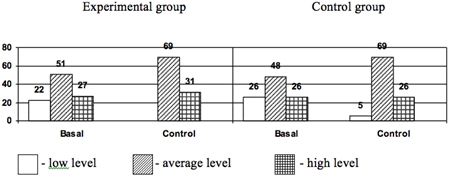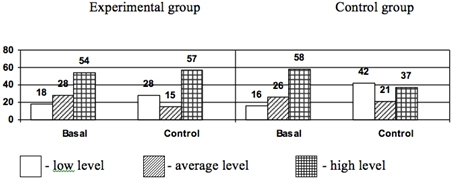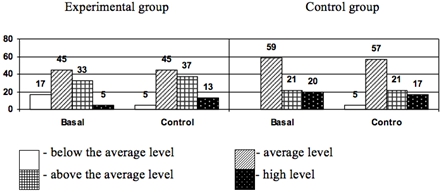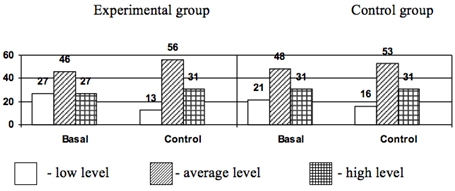ЙОДНАЯ ПРОФИЛАКТИКА КАК ВАЖНЫЙ МЕТОД РАЗВИТИЯ НЕКОТОРЫХ ПСИХИЧЕСКИХ ПРОЦЕССОВ У МЛАДШИХ ШКОЛЬНИКОВ
Коротаева А.Э.1, Софронова Л.В.2
1Студент, 2Доктор медицинских наук, профессор, Пермский государственный медицинский университет имени Е.А. Вагнера
ЙОДНАЯ ПРОФИЛАКТИКА КАК ВАЖНЫЙ МЕТОД РАЗВИТИЯ НЕКОТОРЫХ ПСИХИЧЕСКИХ ПРОЦЕССОВ У МЛАДШИХ ШКОЛЬНИКОВ
Аннотация
В статье сопоставлено значение йодной профилактики школьников в развитии таких психических функций как внимание, память и интеллект.
Ключевые слова: йод, внимание, память, интеллект.
Korotaeva A.E.1, Sofronova L.V.2
1Student, 2Doctor of Medical Sciences, professor, Perm State Medical University named after E.A.Vagner
PREVENTATIVE MEASURES OF IODINE DEFICIENCY AS AN IMPORTANT METHOD OF DEVELOPMENT OF PRIMARY SCHOOL STUDENT’S PSYCHICAL FUNCTION
Abstract
The article considers the influence of iodine drugs administration on children’s psychical functions such as intellect, attention and memory.
Keywords: iodine, intellect, attention, memory.
Almost the whole territory of the Russian Federation belongs to the region with iodine deficiency in the environment. This problem becomes especially acute when it comes to the younger generation, on the grounds that iodine deficiency causes retardation of some important children’s psychical functions. [1, 2, 4]. There are reasonable grounds to believe that the problem of iodine deficiency is a serious modern madicopedagogical problem and requires search of an accessible approach to its solution.
This research work shows the approbation data of the necessary and sufficient conditions of iodine deficiency, which help us to activate children’s psychical functions such as intellect, attention and memory.
The aim of the research work is to investigate the problem of the influence of systemic iodine drugs administration on primary school students' intelligence.
The process and methods of the research:
http://www.multitran.ru/c/m.exe?t=711070_1_2&s1=%F1%EE%E7%E4%E0%ED%E8%E5 %E7%E0%ED%EE%E2%EEForming an experimental (EG) and control groups (CG) of the first-form schoolchildren of Gymnasium №11 named after S.P.Dyaghilev (Perm city). These two groups were identical in age and progress in studies average.
Taking preventative measures of iodine deficiency (organized systemic administration of iodine drugs by children of EG during half a year)
Organization of diagnostics which records changes in their cognitive sphere using neuropsychological research methods (tests “Correction task”, “Logical memory”, Raven methodical technique and Cattell culture free test).
Results.
It was established that arbitrariness of attention in EG after experimental work is much better (pic. 1) - the low-level wasn’t diagnosed (basal level – 22%), the number of children with the average level considerably increased – 69% (basal level – 51%). It was also observed that the index of the high level increased, too – 31% (basal level – 27%), that was not observed in CG. At the same time it is important to say, that the index of the low-level in CG decreased to 5% (basal level – 26%), the index of the average level increased (basal - 48% – control level - 69%), but there are no shifts in the index of the high level (26%).

Fig. 1 - Comparative data of attention productivity of the first-form schoolchildren before and after the experimental work (%)
Despite some negative dynamics in both the classes, experimental work showed that significant difference between EG and CG in logical memory appeared (pic. 2). Thus, the high level in EG was examined in 57% of children from EG (basal level – 54%), while there are only 37% in CG (basal – 58%). The low level of EG children was up by 10% (basal level - 18% – control level - 28%), while the level of CG children –by 26% (basal level - 16% – control level - 42%). On the whole the indices of EG schoolchildren were much higher than CG children, that, despite the reduction of the general results, indicates the positive dynamics.

Fig. 2 - Comparative data of logical memory of the first-form schoolchildren before and after the experimental work (%)
The study of intellectual development of the first-form schoolchildren by the end of experiment showed significant changes in the results of EG (pic. 3). We noticed the considerable growth of the number of schoolchildren with the high level of QI – from 5% to 13% and with above the average level – from 33% to 37%. The number of schoolchildren in CG with the high level decreased from 20% (basal level) to 17% (control level). Indices of the average and above the average levels did not change (basal - 59% – control - 57%; basal - 21% – control - 21% respectively).

Fig. 3 - Comparative data of intellectual level of the first-form schoolchildren before and after the experimental work (%)
The data characterizing the nonverbal intellect of schoolchildren confirmed the positive dynamics of children in EG (pic. 4). The index of the low level of the intellect considerably decreased (basal level - 27% – control level - 13%). This index in CG was not so significant (basal level - 21% – control level - 16%). The same situation was with the index of the average level: by the end of the academic year in EG it went up by about 10 % (basal level - 46% – control level - 56%), in CG – by about 5% (basal level - 48% – control level - 53%). The high level of nonverbal intellect was noticed to increase to 31% in EG (basal – 27%). The dynamics of the high level in CG was not registered (basal level - 31% – control level - 31%).
Fig. 4 - Comparative data of nonverbal intellect of the first-form schoolchildren before and after the experimental work (%)
Therefore, according to the results we can say that the indices in CG are lower than in EG. Having remained almost at the same basal level they were little from indices of the experiment. At the same time the significant growth of indices toward the increase of the average and high levels and the decrease of the low level in all the parameters was registered.
The same thing was registered by the method of independent characteristics: parents and teachers of the schoolchildren noticed that the children became quieter and more attentive at the lessons and doing homework at home. Moreover, the final examination of the schoolchild in EG showed the higher level of knowledge than in CG.
Conclusion.
The results of the experimental work registered the development of the intellectual sphere of the first-form schoolchildren of the experimental group and confirmed enough effectiveness of the chosen conditions for solving the problem of the research.
References
- Joddeficitnye zabolevanija u shkol'nikov Permskogo kraja. Metodicheskie rekomendacii. – I.P. Korjukina, L.V. Sofronova, R.N. Trefilov i dr. – Perm', 2006.
- Maslova, O.I., Balkanskaja, S.V. Kognitivnye funkcii shkol'nikov v kriticheskie periody zhiznedejatel'nosti. Materialy XVIII s#ezda Fiziologicheskogo obshhestva im. I.P.Pavlova. – Kazan', 2001.
- Ratanova, T.A., Shljahta, N.F. Psihodiagnosticheskie metody izuchenija lichnosti. – M., 1998.
- Formuljar diagnostiki, lechenija i profilaktiki joddeficitnyh zabolevanij u detej / L.V. Sofronova, I.P. Korjukina i dr. – Moskva–Perm', 2002.
